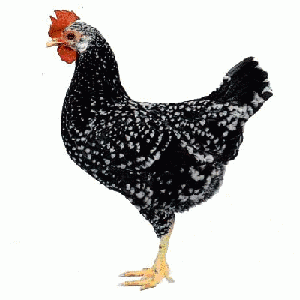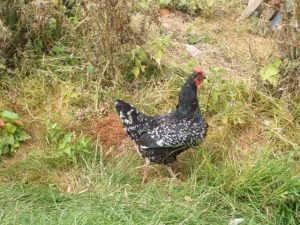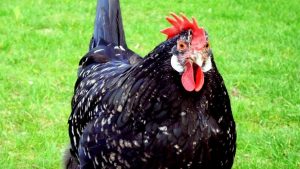
Images


Overview
The Ancona Chicken is named after the city of Ancona in Italy. Believed by many to be closely related to the original Mottled Leghorn further imports in the 1890’s and later from both America and Italy concentrated the breed characteristics to the spangled fowl of today.
The Ancona chicken was exported to England throughout most of the 19th century and was brought from there to America in 1888. 10 years later, the breed was officially recognised by the American Poultry Association.
Within Italy they were found in reds, browns and white which would account for the occasional copper appearing in neck hackles it being a genetic throwback. The Ancona has become hard to get hold of and has a “watch” status with the Livestock Conservancy as there is a global population of less than 10,000.
Ancona chickens are kept mostly as egg layers and fully grown their weight averages around 4.6-5.5lbs (2.1-2.5kg) for males and 4-4.6lbs (1.8-2.1kg) for females. Bantams hens weigh 22oz (625g) and the Bantam roosters weigh 26oz (740g)
Eggs
Size
Large size eggs weighing 1.8oz (50g) or more
Color
White to cream eggs.
Production per year
160-180 eggs
When do they start laying eggs?
They may start laying eggs at 5 months (20 weeks)
Ancona Characteristics
Temperament / Are they good as pets?
Known to be extremely active and great foragers, they need to be kept in a large space so do not make well for backyard pets. They are hardy so are able to handle harsh winters and warm summers so are able to survive in most climates.
How do I tame Ancona chickens?
Taming your chickens is easier the younger you buy them, if you’re buying older chickens ask the breeder whether they’re used to human interaction. To tame your chickens try feeding them from your hand and handle them whilst they are young. This way you get them used to human interaction.
How many do I need to buy?
Chickens are social creatures and do not cope well by themselves, you should get at a minimum 2 chickens, but 6 would be recommended as the perfect small flock.
How much space do they need?
Their coop needs to have at least 11 square feet per chicken, but don’t give them too much space as a large coop with not enough chickens means they’ll have difficulty generating enough heat to keep them all warm.
As they are extremely active chickens they do not fare well in small spaces, therefore their run needs to be at least 250 square feet per chicken to allow them to range freely.
Will they mix with my other chickens?
Yes, they should mix with other chickens. Problems may arise if your current chickens all have a similar appearance that differs from the look of the Ancona chicken as they may bully the newcomers.
Appearance
Ancona chickens are available large and miniature but compared to other breeds on the smaller side and have black plumage with a spray of white spots. They have striking yellow legs and beak which have stripe of black on them.
They can have either a rose comb or a single comb, which is more common, with long bright red wattles as in other Mediterranean breeds with a white v shaped tip to the feathers and beetle green metallic sheen to the feathers.
Chicks are very cute and have a combination of white and black patches.
Feeding
What should I feed them?
When you first get your chicks, it is best to feed them chicken mash, which is refined chicken feed with a higher protein content (19{cfcd481556a8b43fba6af451761032bd323e94372a0c1e607}) to help them develop healthily.
Once they reach 6 weeks you can switch them to chicken pellets or growers mash, these contain less protein (15-16{cfcd481556a8b43fba6af451761032bd323e94372a0c1e607}) and you can feed them this until they’re 18 weeks or 4 months old.
Once they reach 18 weeks you can gradually introduce layers mash or pellets, this feed contains all the nutrients your chickens will need to help them with egg production, this feed typically contains around 16{cfcd481556a8b43fba6af451761032bd323e94372a0c1e607} protein.
How much should I feed them?
Your chickens can eat anywhere between 2.9oz (80g) to 4.2oz (120g) a day. On average a chicken will eat around ¼ (113g) of a pound of feed a day. Try feeding them this amount and adjust according to their consumption.
You could either leave the feed in a feeder for them to eat away at for the day or you could feed them in the morning and evening.
What can’t they eat?
Chocolate and beans are the two most important things that should be kept far away from chickens. The theobromine in chocolate causes heart problems for chickens once consumed and is fatal. Similarly, the phytohemagglutinin found in dried and raw beans is fatal for chickens, so make sure there are no bean plants in the vicinity of your coop.
It is considered illegal to feed your chicken scraps from the kitchen in the UK due to the potential risk for disease contamination. Mouldy foods should also not be fed to chickens as they contain nasty bacteria that can cause health problems.
What do I need to keep chickens?
You should have a minimum of 1.1 or 11 square feet in the coop per chicken. These chickens need lots of space as they are happiest when foraging, at least 250 square feet per chicken is recommended. They need a small perch to sleep on at night as well as a wooden box filled with wood shavings or hay to lay their eggs. Ancona chickens are good fliers so any fences need to be high enough that they can’t fly over. You need a fence over and around the coop that is sunk at least 8 inches into the ground. This should protect them from any predators at night.
Be sure to also shut all the chickens into their coop at night to keep them safe. The chickens need access to water to drink which you should try and keep out of direct sunlight as they prefer cool water. Water containers should be sturdy enough that they can’t be tipped over and tall enough that they can’t step into it.
Grit is important for egg production so always have some accessible for your chickens.
Where To Buy Ancona Chickens
Although the breed is rare fertilized eggs can be found from hatcheries and shipping to your via the mail!
Chicks can be bought from a few days old.
Maturing laying chickens can be found online through reputable breeders.
Breed Tips
- For laying rather than showing use the lighter birds especially in the under fluff. Check also for a very upright tail discarding any squirrel tails as they are normally poor layers.
- For breeding the birds with no white splashing and no white in the under fluff are the best consistently.
- Supreme layers in relation to food consumption, and will lay longer into the winter compared to most breeds, without the need for supplemental light.
- The roosters (cockerels) are slow and difficult to fatten.
- This is a non-sitting fowl, generally not broody by nature so wont sit on a clutch of eggs.
- Very hardy.
- Very alert and fast temperament combined with being a black/dark color makes them idea if you live in an area where birds of prey pose a predation threat.
Breed Club Secretary
Mr P. E. Smedley
Philip Leckby House, Flaxton, North Yorkshire,
YO6 7QZ
UK
